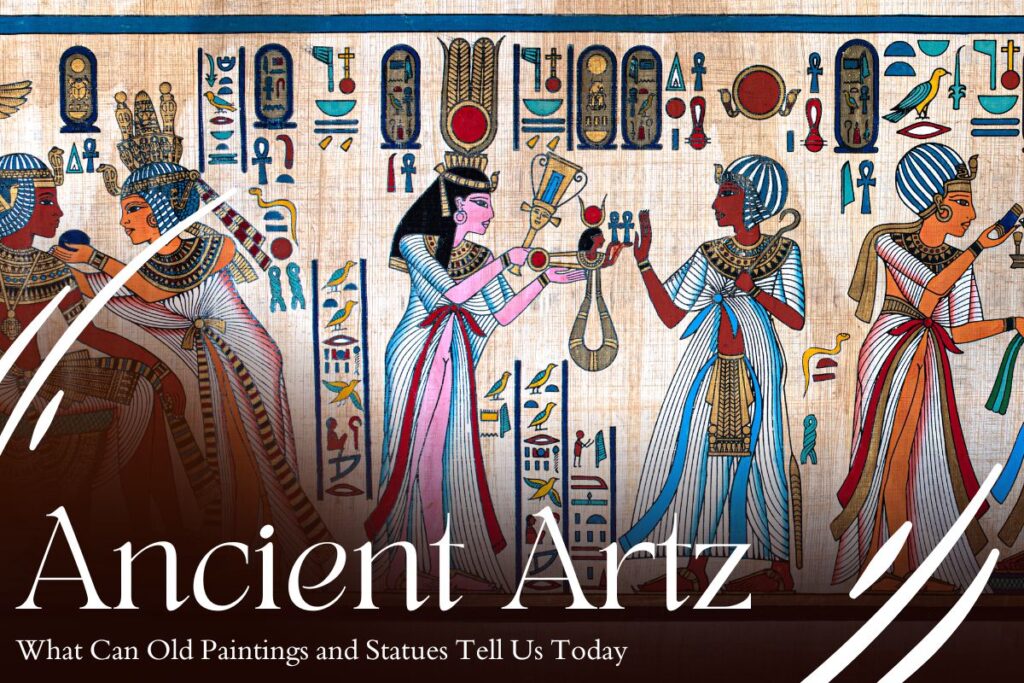Table of Contents
Introduction: The Power of Ancient Artz Throughout History
Ancient artz has long been a captivating window into the human experience, crystallising emotions and beliefs—stories of extinct communities. Some consider them irrelevant remains of the distant past, or do not see their importance in deciphering how humanity evolved. But ancient art is more than something to glance at; it deserves and calls on us to consider its more profound significance and connections.
C’mon with me as we explore ancient art — a world of endless brush strokes and chisel chips, each infused with profound, hidden truths just dying to be revealed. We can fight back against the stigma of these classics and value their presence in history and the present day.
The Stigma Against Ancient Art and Its Historical Roots

There’s a long history of ancient art being unfairly disadvantaged. Many communities often saw artistic productions as superfluous or unneeded. That misconception, in turn, comes from an ancient belief that the practical tops all. In some cultures, Artz practitioners were occasionally stigmatised. They were believed to be dreamers, not social contributors. This attitude obscured the genuine importance of artistic creation and its impact on community ethos.
Religious beliefs also influenced negative attitudes toward ancient art. There was an attitude that art could be idolatrous or get in the way of spiritual work. These dogmas inhibited creative freedom and suppressed variety in ancient artz. Over centuries, these misunderstandings persisted, becoming obstacles for artists who wanted to express themselves to the world. The prejudice against ancient art has reverberated throughout history, shaping how we understand creativity.
Understanding Ancient ancient artz Forms and Their Purpose
Old things, old stuff, Ancient art, and the beautiful in history. Art is an incredible kaleidoscope of human expression across cultures and time. It’s something from each boss, telling tales, beliefs, or timeless feelings. Ancient artz has transcended cave primary colour markings to reflect society at that time. Some objects were religious relics, while others honoured the mundane or essential happenings. These works are highly symbolic of the values and challenges their artists face.
Artisans used raw materials such as clay, stone, and colours that naturally lay around them. This relationship to nature beautified the art and rooted it in its cultural relevance. Also, ancient art was an ancient artz for us. Groups came together to build larger-than-life structures or murals telling the story of a people. Through collaboration, connections were created, and history was kept for others to delve deeply into later.
Overcoming Misconceptions About Ancient Artz
Hollywood myths concerning ancient art are no doubt a result of ignorance. People consider it archaic or crude, and don’t understand the science behind these things that people have made. The reality is that each item has a story rooted in ancient artz and historical context. Many people often ignore the skills needed to create ancient art. Artists used time-honoured methods, demonstrating control of materials and forms, techniques handed down over generations.
Their opponents also sometimes claim ancient artz from the past isn’t relevant to our contemporary world. And yet, these texts speak loudly to such modern issues as identity, community, and religion. They are reminders of our collective human story. Sharing with your kids an openness and thoughtfulness about the ancient arts is how we can change perceptions. Embracing that depth deepens our appreciation for a wide array of historical expression—no longer seen with old eyes but celebrated for their universal contribution.
The Relevance of Ancient Artz in Today’s Society
Old School ancient artz still dumb on son aiyatollah Old artz lives game. Brutally contemporary as our internet age may be, it can’t help but make ancient art feel like a jaunty throwback. We want something authentic and honest; we find it in these venerable relics of the past. The old methods and designs inspire modern-day artisans who blend the practice with newer ideas. This blending of styles has created a new idiom that represents today’s society.
Conclusion: Embracing the Beauty and Importance of Ancient Art
Old art contributes to humanity’s search for expression and meaning. With their history and meaning, these forms narrate the stories of ancient artz generations so they resonate across time and place. They connect us with our forebears and flash us an image of common humanity. We value ancient art for its aesthetic, yet we also place tremendous value on what it can do as a tool to build bridges amongst people of different times and cultures. Accepting this kind of art will enable us to cross the border lines and create a better society for everyone.
The point of our oldies but goodies is that they are lovely and meaningful, and these things can drive us to ponder who we’ve been, who we are now, and what we might be together. 4- It forces us to discuss old arts, which influence a way of life. Old is not doomed automatically to be ancient artz old-fashioned, and coming together where there is art that has lasted for centuries, we develop passion because it lets us see what matters to people and the past, the existence of the future.
